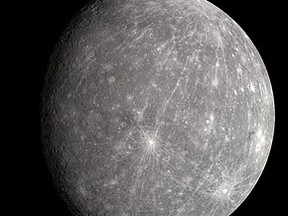The mysterious planet Mercury

Article content
Mercury, the smallest and innermost planet in our solar system, is a world of extremes and contradictions. A desolate, crater-scarred rock hurtling through space, Mercury offers a fascinating glimpse into the early formation of our stellar neighborhood and the powerful forces that shape planetary bodies.
Despite its diminutive size, Mercury packs an unexpected punch in terms of scientific intrigue and challenges our preconceived notions of planets close to their host stars.
Named after the swift Roman messenger god, Mercury lives up to its reputation. It boasts the shortest orbital period of any planet in our solar system, completing a full revolution around the Sun in a mere 88 earth days. However, its rotational period is remarkably slow – one Mercurial day lasts approximately 59 earth days.
This unusual spin-orbit resonance means that while Mercury zips around the Sun with remarkable speed, it takes its time turning on its axis. As a result, a single day on Mercury is longer than its year! This peculiar dynamic creates a unique temperature regime on the planet’s surface.
From a distance, Mercury might appear as a close cousin to our own Moon. Both are barren, airless bodies adorned with craters formed by billions of years of asteroid and comet impacts. However, a closer look reveals some crucial differences.
Mercury possesses a surprisingly high density, suggesting a massive iron core that comprises a significant portion of its interior. This iron-rich core sets Mercury apart from other terrestrial planets and raises questions about the planet’s origins and evolution. One prominent theory suggests that Mercury may have once been much larger, but a colossal impact stripped away much of its outer layers, leaving behind a dense, metal-rich remnant.
The surface of Mercury is a study in contrasts. Sweltering temperatures on the sunlit side can reach a scorching 430 degrees Celsius, making it hot enough to melt lead. Conversely, the permanently shadowed craters at the planet’s poles harbor some of the coldest temperatures in our solar system, dipping to minus 180 degrees Celsius. This incredible temperature range is the most extreme of any planet. Mercury owes this wild fluctuation to its lack of atmosphere. With no substantial atmosphere to trap heat or distribute it around the planet, temperatures vary drastically between day and night.
The stark Mercurial landscape is riddled with evidence of past volcanic activity. Smooth plains composed of ancient lava flows point to a time when Mercury was a geologically active world. Scientists have also uncovered peculiar features known as “hollows” on Mercury’s surface. These shallow, irregular depressions are thought to be caused by volatile substances, perhaps including water ice, evaporating and escaping into space. The presence of ice within craters near the poles—areas perpetually shielded from the Sun’s searing heat – has led scientists to rethink their assumptions about this seemingly fiery world. It’s a tantalizing hint that even in the harshest environments, the building blocks of life may find a way to persist.
The exploration of Mercury has been a challenging endeavor. The planet’s proximity to the Sun makes it difficult to study with ground-based telescopes, and sending spacecraft to its harsh environment presents numerous technological hurdles.
Nonetheless, two NASA missions have made significant strides in unveiling the secrets of Mercury. The Mariner 10 mission in the 1970s conducted the first flybys of Mercury, providing us with initial glimpses of its cratered surface and hints of its unusual internal composition. Decades later, NASA’s MESSENGER spacecraft made history by becoming the first probe to orbit Mercury. MESSENGER spent four years meticulously mapping the planet’s surface, studying its composition, and delving into its magnetic field.
Data from the MESSENGER mission revolutionized our understanding of Mercury. The spacecraft confirmed the planet’s high density and revealed an unexpected abundance of volatile elements like sulfur and potassium on its surface. It also detected signs of past volcanic activity and provided compelling evidence for water ice in the polar craters.
Despite these groundbreaking discoveries, Mercury still harbors many mysteries. The origin of its massive iron core, the exact processes driving its volcanic past, and the full extent of potential ice deposits remain captivating puzzles for planetary scientists to solve.
Mercury, the enigmatic little planet, continues to fascinate and challenge us. As a testament to the extremes that exist in our solar system, it compels us to broaden our perspectives on planetary formation and the potential for life in seemingly inhospitable corners of the cosmos. With future missions in the realm of possibility, Mercury promises to reveal even more of its secrets, ultimately contributing to a greater understanding of our place in the vast and wondrous universe.
Tim Philp has enjoyed science since he was old enough to read. Having worked in technical fields all his life, he shares his love of science with readers weekly. He can be reached by e-mail at: tphilp@bfree.on.ca or via snail mail c/o The Expositor.
Postmedia is committed to maintaining a lively but civil forum for discussion. Please keep comments relevant and respectful. Comments may take up to an hour to appear on the site. You will receive an email if there is a reply to your comment, an update to a thread you follow or if a user you follow comments. Visit our Community Guidelines for more information.